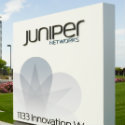
Juniper's Session Smart Routing SD-WAN platform got a facelift this week with new security features, hardware and configuration options.
Since acquiring 128 Technology in 2020 for $450 million, Juniper has been gradually updating its SD-WAN services with 128's session-aware routing (SSR) technology. The goal of session-aware routing is to deliver more visibility into individual user experiences versus other SD-WAN suppliers that use a tunnel and IPsec approach. Last February, Juniper combined its Mist AI and SRX secure branch gateway with 128's Session Smart SD-WAN technology.
On this episode of The Light Reading Podcast, Sue Graham Johnston, president of 128 Technology, explains how 128 aims to build a session-aware network and how that improves user experience as well as enterprise security.
As of this week, Juniper's SD-WAN customers can now configure, manage and utilize the SSR technology via the Mist cloud and AI engine, says Juniper. In addition, the networking company has added a Branch Security Pack with intrusion detection and prevention systems (IDS/IPS) and URL filtering capabilities in an effort to simplify deployment of the SSR platform.
"Adding (IDS/IPS) and URL filtering to what we already had in the box really hits the requirements for the bulk of our customers for their on-premises security," says Karen Falcone, senior director of product marketing for Juniper's service provider channel. "For SSR, we've always had a hallmark of our router being super secure, so this brings those additional features that we needed to round out the branch requirements."
Juniper's customers can now also deploy SSR on Juniper-branded hardware, the SSR120 and SSR130 x86 devices. Customers can deploy the new SSR hardware devices with a QR claim code for zero touch provisioning, says Falcone. The SSR120 and 130 are designed for small to mid-sized businesses and include multiple WAN link options such as LTE. The SSR1000 line is designed for headend, data center and cloud deployments.
Hardware optionality
Falcone says the new devices provide more hardware options for customers – some customers prefer to use their own or existing hardware; want to use a x86 device from one of Juniper's partners such as Silicom, Lenovo and Lanner; and other customers will now have the choice to order a Juniper-branded device for SSR.
"A lot of Juniper customers are used to purchasing this way, so it provides an opportunity for them to get a one-stop-shop SSR on the hardware, ordered from Juniper, off the shelf and out to them. It's a nice rounding out of our hardware portfolio," explains Falcone.
Juniper has also been increasing its focus on adding AI capabilities to its SD-WAN services, which distinguishes it from other SD-WAN providers, adds Falcone. The company's background in routing, acquisition of Mist and acquisition of 128 Technology has led to "a SD-WAN solution that's AI-driven. We feel like that sets us apart from this super-crowded field and differentiates us in a way that would be hard for a competitor to catch up with," explains Falcone.
In addition to Juniper, SD-WAN providers such as Zayo's QOS Networks, Masergy and Palo Alto have been working to distinguish themselves from other SD-WAN companies by developing their AIOps features to help customers better analyze and act on data from their SD-WANs.
Differentiation will be increasingly important as the SD-WAN market matures. Research firm Futuriom forecasts continued, steady growth for the SD-WAN market, which could reach $3.5 billion by 2022 and $4.6 billion by 2023.
— Kelsey Kusterer Ziser, Senior Editor, Light Reading
About the Author(s)
You May Also Like










